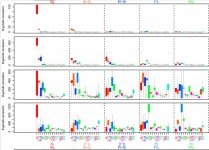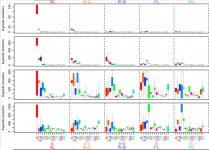The mass of E-V13 in the Balkans has nothing to do with some stray Turk who arrived during the Ottoman occupation. It has an expansion date in The Bronze Age. It has a start burst expansion from right around the area where it is currently the most frequent in the Balkans. It spread from there into Italy, much of it perhaps during the first millennium BC, as we know from Boattini et al's relative dating of the arrival of different haplogroups into Italy. The most parsimonious and scientific explanation is that it has been in that area since at least the Bronze Age. Anything else is just more Balkan obfuscation for ethnic partisanship and an attempt to make the Albanians and anyone else who carries it "foreign" to the area when in fact it is the "Slavs" and whatever yDna they carried who are the most recent arrivals.
http://en.wikipedia.org/wiki/Haplogroup_E-V68#E-V13
Ed. I should add that neither can one say that all the EEF in modern Balkan peoples has been in situ since the Neolithic. Slavs also carry EEF, along with WHG and ANE, as did the Thracians and other Indo-European peoples. However, ANE was definitely not present in the Neolithic so it is the latest of the major ancient population groups to arrive.
Of course, Angela, E-V13 carriers arrived earlier, and what is interesting, Ottoman Turks didn't change significantly genetic picture of Balkans.
I gave a example how someone will have wrong conclusion if he or she interpret data mistakenly, wrenches out of context, pulls out a piece of the puzzle.
...
Yes we know when Slavs arrived, but populations of the Balkans have no very significant R1a component. And R1a carriers arrived to the Balkans not only as Slavs, but much before Slavs, there are Y-DNK researches.
If we look R1a we can see in the Balkans (source Eupedia): Albania 9%, Greece 11,5%, Macedonia 13,5%, Serbia 16%, Bulgaria 17%, Romania 17,5%, Croatia 24%.
Except for Croatia, differences between countries are not big.
All nations in the Balkans are mixed, indigenous populations with newly arrived populations.
For example, someone can see Serbs and Romanians are similar but Serbs speak Slavic language and Romanians speak Romance language and there is explanation for this.
Dacians (probably Thracian tribe) spoke Dacian language (maybe close to Balto Slavic) which disappeared in 6th century due to Romanization.
On the other side Southern Slavs are Slavic by language and culture, not by genetic.





